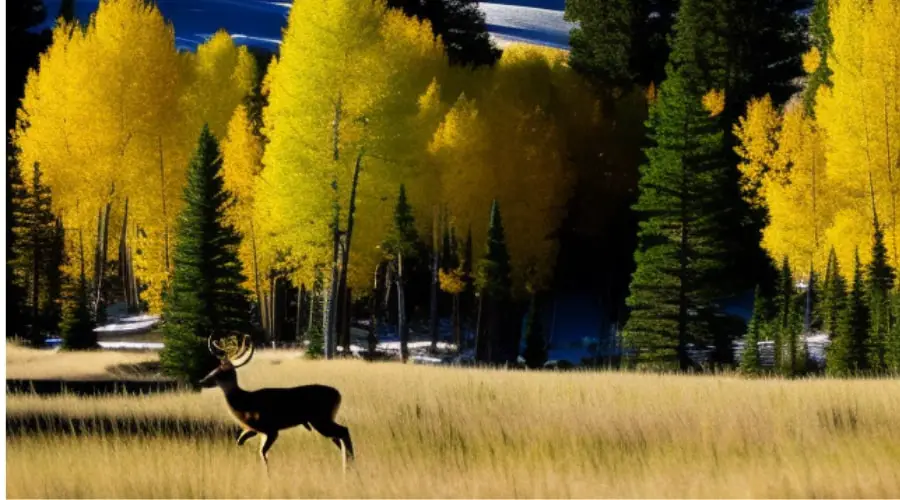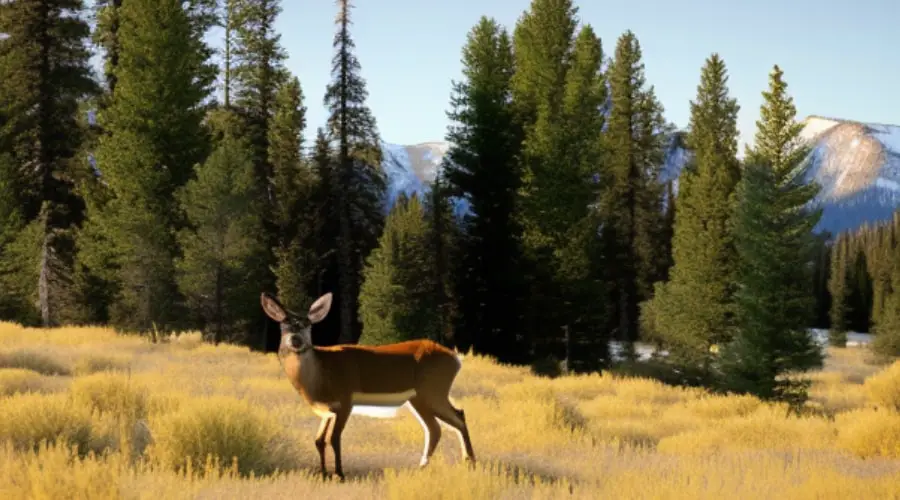Mule deer is the most sought-after big game animal across North America. From desert dunes to lush forests and expansive prairies, these creatures can be discovered in a multitude of habitats. Though they may reside in many locations, some places offer the perfect environment for them to thrive.
Mule deer are one of the most beloved and renowned animals in America’s Western landscape. With their large ears resembling that of a mule, these deer have aptly been named. In the summertime, they boast a tannish-brown hue and in winter months the color deepens to brownish-gray.
In this blog post, we will explore mule deer habitat and discuss ways to improve their habitat for the benefit of both the deer and hunters. We will also provide tips on how to find good mule deer habitats in your area.
Table of Contents
- Mule Deer Habitat Alberta
- Mule Deer Habitat Washington State
- Mule Deer Habitat Arizona
- Mule Deer Habitat Idaho
- Mule Deer Habitat Texas
- California Mule Deer Habitat
- How To Find Mule Deer Habitat
- What Is Good Mule Deer Habitat
- Improving Mule Deer Habitat
- Conclusion

Mule Deer Habitat Alberta
Mule deer are very versatile animals and can adapt to a wide variety of habitats. In Alberta, they are typically found in open forests or parklands. But can also be seen in grasslands, shrublands, and agricultural areas.
They prefer areas with plenty of cover (such as trees, bushes, or tall grass) but also need ample space to move around and graze. Alberta’s mule deer populations have been steadily increasing, and their range is now extending from the prairies to the peaks of Alberta’s foothills.
Moreover, they are spreading further north into boreal zones as well. The common habitat of the species is aspen groves, open grasslands with interspersed trees. Mule deer are most active at dawn and dusk but can be seen at any time of day.
They typically eat grasses, leaves, twigs, and buds from plants, but will also eat berries, nuts, and flowers. Mule deer are prey animals so they are very cautious and often stay hidden until they’re sure the coast is clear.
Mule Deer Habitat Washington State
Mule deer are residents of the state of Washington. In eastern Washington State, mule deer are abundant and inhabit almost the entire length of the state. Ranges from its Cascade Mountain range to its Idaho border.
These animals take up residence in a range of environments, from coniferous forests to parklands and even shrub-filled areas as well as alongside rivers. In some areas, they occur at high densities. In others, they are sparsely distributed.
They are browsers that feed on a wide variety of plant species. Principal foods include herbaceous plants, shrubs, and trees. Favored foods vary with habitat type and season. Mule deer make seasonal movements in response to changes in food availability and weather conditions.
In Washington State, mule deer depend on healthy populations of sagebrush for winter cover and for their diet during the winter months. The majestic mule deer is prevalent throughout the eastern slopes of Washington’s renowned Cascades and its surrounding areas.
Mule Deer Habitat Arizona
Mule deer can be found throughout desert regions as long as Abundant greenery provides much-needed refuge and sustenance. Rocky Mountain mule deer, possessing the highest population in Arizona, are quite resilient. From dry deserts to steep mountain ranges, they can thrive in a variety of terrains.
In order to regulate their body temperature, Mule Deer migrate from higher elevations in the summertime and descend towards lower areas during winter.
The deer use four main types of habitat in Arizona: pinyon-juniper woodlands, ponderosa pine forests, riparian areas, and desert scrub. Mule deer live in these woodlands year-round but prefer to stay near openings where they can see danger coming.
Mule Deer Habitat Idaho
The Idaho Department of Fish and Game manages mule deer habitat throughout Idaho. In general, mule deer are found in open to semi-open areas with a mix of sagebrush, grasses, and conifers. They prefer areas near water sources.
In southern Idaho, mule deer are typically found in mountainous areas where the vegetation is more dense. In contrast, northwestern Idaho has a more open country with rolling hills and few trees. There are also large expanses of private land in this region that are used for agriculture and ranching.
These habitats can be harsh with winters that include deep snow drifts. Mule deer have adapted to these conditions by using food plots planted by farmers and ranchers and by migrating between adjacent habitats.
Idaho’s habitat for mule deer is incredibly varied, and these majestic creatures are now inhabiting many urban centers. You can observe them all year round in Idaho’s beautiful Wood River Valley.

Mule Deer Habitat Texas
During wet weather, the mule deer population of Texas can reach up to a quarter-million. Conversely, this number is halved during dry conditions and drops down to approximately 150,000. A majority of the mule deer population in Texas, estimated at around 80-85%, resides within the Trans-Pecos Region whereas the remaining roam across Panhandle and western Edwards Plateau regions.
In Texas, mule deer inhabit the western half of the state. They prefer open areas with scattered woodlands and brushy cover. Texas is a hidden gem in the world of mule deer hunting, and Wildlife Systems provides splendid chances to hunt on multiple private ranches located in West Texas.
California Mule Deer Habitat
California mule deer are browsers, which means they mostly eat leaves, twigs, and shoots from trees and other plants. They also eat some grasses. Mule deer live in several types of habitats, including coniferous forests, oak woodlands, chaparral (a type of shrubland), and desert scrub.
Generally, the California mule deer has a penchant for hilly regions, particularly oak woodlands. These creatures are browsers and consume mostly shrubs and leave that makeup 90% of their diet; grasses make up the remaining 10%.
Mule deer need areas with plenty of good hiding places from predators and areas where they can find food. They also need access to water. In California, mule deer live in a variety of habitats including the Coast Range, the Sierra Nevada Mountains, the Central Valley, the Mojave Desert, and the Peninsular Ranges.
How To Find Mule Deer Habitat
There isn’t one easy answer to this question, as the habitats that mule deer prefer can vary depending on where you are located. However, in general, mule deer tend to prefer open areas with plenty of access to food and water. They also like sheltered areas where they can hide from predators.
Some good ways to find mule deer habitat include studying maps of the area you are interested in, looking for signs of deer activity (such as tracks or droppings), and asking local hunters or landowners for advice.
The best way to find mule deer habitat is to look for clues on the ground. The presence of deer scat, tracks, and rubs are all good indicators of where they are spending their time. You can also check out local wildlife maps to find areas that are known to be prime mule deer habitats
Here are some valuable tips that will ensure that your hunt is successful and ethical!
First, you’ll need to find an area that has the right mix of vegetation and terrain to support mule deer. The best way to do this is by looking at aerial photographs or maps of the area. You’ll want to look for areas with dense vegetation (especially brushy areas) near open spaces or ridges.
Next, you’ll need to do some field research to verify that the area does have a healthy population of mule deer. This can be done by looking for signs of deer activity such as tracks, scat, rubs, and browse lines. You can also watch for herds of deer while you’re out in the field.
Once you’ve verified that an area supports mule deer, you’ll need to decide on the best-hunting methods and strategies. Different areas may require different tactics, so it’s important to do some research into local deer behavior before heading out. You should also consider obtaining permission from the landowner if necessary.
Finally, once you’re in the field hunting, be sure to practice safe and ethical hunting practices. This includes following all laws and regulations, wearing blaze orange for visibility, avoiding shooting at deer from too far of a distance, and making sure you have an accurate means of determining the range of your target.
What Is Good Mule Deer Habitat
Mule deer require four basic things to thrive: food, water, shelter, and space.
Food sources can include grasses, weeds, shrubs, tree browse, cactus fruits, and flowers.
Water is essential for all life and can be found in ponds, streams, lakes, marshes, and even wet meadows.
Shelter from the weather and predators is also necessary and can be found in forests of Douglas fir, ponderosa pine, or mixed coniferous forest types. Aspen groves are also popular with deer. Mule deer will bed down close to water if available.
Space is needed for movement as well as for feeding and resting. A minimum of 100 acres per deer is recommended to ensure a healthy population. Good fencing and land management practices are essential to providing adequate habitat for mule deer.
Improving Mule Deer Habitat
There are many ways to improve mule deer habitat, but some of the most important methods include restoring and protecting riparian areas, planting shrubs and trees, and creating salt licks.
Riparian areas provide crucial food and water resources for deer, so it’s important to protect these areas by restoring them if they’ve been damaged and by preventing further development.
Planting shrubs and trees can also help create better wildlife habitats; for example, evergreen trees provide good cover for deer during winter months.
And finally, creating salt licks is a great way to attract deer and keep them healthy. Salt licks are made by mixing salt with grains, and then scattering them around the area; this provides a much-needed source of minerals for deer.
By taking these steps, mule deer can have better access to food and water resources, which will help improve their overall health and well-being.
Conclusion
In conclusion, mule deer habitat can be found all throughout North America in a variety of states. In order to find them, it is important to understand what kind of habitat they prefer and where their preferred habitats are located. The mule deer’s ability to adapt to various habitats is one of the things that makes them such a successful species.
However, human encroachment and other factors have led to a decline in suitable mule deer habitats in many areas. Conservation efforts focused on preserving and restoring mule deer habitat can help ensure the future of this iconic species.
